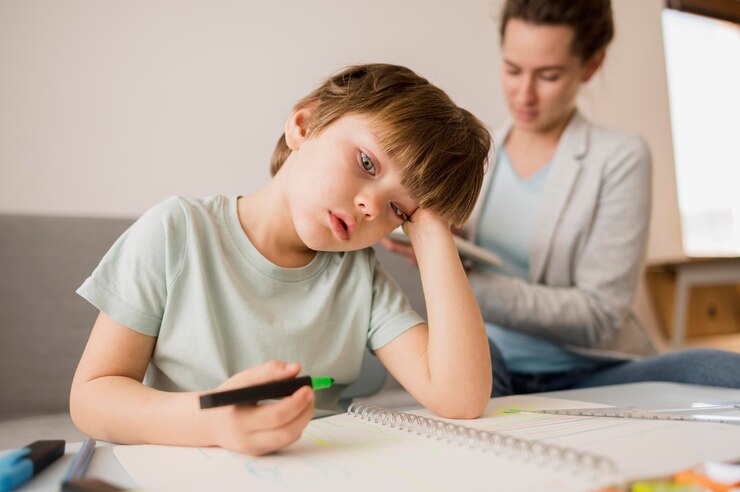What is ADHD in Children (Attention Deficit Hyperactivity Disorder)?
 Learn to recognize signs of ADHD in kids with this guide: ‘ADHD in Children: How to Identify if Your Child has TDA-H?’ Get insights now!
Learn to recognize signs of ADHD in kids with this guide: ‘ADHD in Children: How to Identify if Your Child has TDA-H?’ Get insights now!
ADHD in Children, or Attention Deficit Hyperactivity Disorder, is a neurodevelopmental disorder that affects individuals’ ability to sustain attention, control impulses, and regulate their activity level. It is one of the most common childhood disorders, with symptoms often persisting into adolescence and adulthood. ADHD is characterized by a pattern of inattention, hyperactivity, and impulsivity that interferes with daily functioning and development.
Common signs and symptoms of ADHD in children
The signs and symptoms of ADHD can vary widely among individuals but generally fall into two categories: inattention and hyperactivity-impulsivity. Children with ADHD may exhibit difficulty sustaining attention on tasks, frequently make careless mistakes, have trouble organizing tasks and activities, and often avoid or dislike tasks requiring sustained mental effort. They may also struggle to follow through on instructions and fail to finish schoolwork or chores. In addition to inattention, hyperactivity and impulsivity may manifest as excessive fidgeting or squirming, difficulty remaining seated, talking excessively, and interrupting or intruding on others’ conversations or activities (ADHD in Children).
Importance of early identification and diagnosis
Early identification and diagnosis of ADHD are crucial for providing timely intervention and support to affected children. Recognizing ADHD symptoms early allows parents and educators to implement strategies to help children manage their challenges effectively and improve their academic and social functioning. Early intervention can also prevent potential academic difficulties, low self-esteem, and behavioral problems that may arise if ADHD symptoms are left untreated.
 The role of parents in recognizing ADHD in their child
The role of parents in recognizing ADHD in their child
Parents play a pivotal role in recognizing ADHD symptoms in their child. They are often the first to observe behavioral patterns and changes that may indicate ADHD, such as difficulty focusing on tasks, impulsivity, or hyperactivity. By maintaining open communication with teachers, caregivers, and healthcare professionals, parents can gather valuable information and collaborate on identifying and addressing their child’s needs (ADHD in Children).
How ADHD affects a child’s academic performance and social interactions
ADHD can significantly impact a child’s academic performance and social interactions. Inattentiveness and impulsivity may interfere with the ability to concentrate in class, follow instructions, and complete assignments on time. As a result, children with ADHD may experience academic underachievement, difficulty staying organized, and challenges with time management. Moreover, impulsivity and hyperactivity can affect social interactions by making it difficult for children to engage in cooperative play, follow social cues, and regulate their emotions, leading to peer difficulties and feelings of isolation.
 Strategies for identifying ADHD in children at home and in school
Strategies for identifying ADHD in children at home and in school
Identifying ADHD in children requires a comprehensive approach that involves observation, communication, and collaboration between parents, teachers, and healthcare professionals. At home, parents can monitor their child’s behavior, routines, and interactions to identify patterns of inattention, hyperactivity, and impulsivity. They can also keep track of academic performance, social interactions, and emotional well-being to assess how ADHD symptoms may be affecting various aspects of their child’s life. In the school setting, teachers can provide valuable insights by observing the child’s behavior in the classroom, noting any difficulties with attention, focus, or behavior regulation, and communicating with parents about their observations. Collaborating with healthcare professionals, such as pediatricians, psychologists, or psychiatrists, can further support the identification and evaluation of ADHD through comprehensive assessments and evaluations (ADHD in Children).
Professional assessments and evaluations for ADHD diagnosis
Professionals trained in diagnosing ADHD, such as pediatricians, child psychologists, or psychiatrists, conduct thorough assessments and evaluations to diagnose the disorder accurately. These assessments typically involve gathering information from multiple sources, including parents, teachers, and the child, through interviews, questionnaires, and behavioral observations. Additionally, professionals may use standardized rating scales and diagnostic criteria outlined in the Diagnostic and Statistical Manual of Mental Disorders (DSM-5) to assess the presence and severity of ADHD symptoms. Psychological testing, such as cognitive assessments and attention tests, may also be administered to further evaluate the child’s cognitive functioning and attentional abilities.
Treatment options for children with ADHD
Treatment for ADHD often involves a multimodal approach that combines behavioral interventions, psychoeducation, and, in some cases, medication management. Behavioral interventions, such as behavioral therapy and parent training programs, focus on teaching children and parents strategies to manage ADHD symptoms effectively, improve self-regulation skills, and establish routines and organizational strategies. Psychoeducation aims to educate children, parents, and educators about ADHD, its symptoms, and strategies for coping with challenges. Medication management, including stimulant and non-stimulant medications, may be prescribed by healthcare professionals to help manage ADHD symptoms when behavioral interventions alone are insufficient (ADHD in Children).
 Supporting a child with ADHD: tips for parents and caregivers
Supporting a child with ADHD: tips for parents and caregivers
Supporting a child with ADHD involves creating a supportive and structured environment that addresses their unique needs and challenges. Parents and caregivers can implement the following tips to support their child with ADHD:
- Establish routines and schedules to provide structure and predictability.
- Break tasks into manageable steps and provide clear instructions.
- Use positive reinforcement and praise to encourage desired behaviors.
- Provide opportunities for physical activity and outlets for excess energy.
- Teach self-regulation strategies, such as deep breathing or mindfulness exercises.
- Foster open communication and encourage the expression of feelings and emotions.
- Work collaboratively with educators and healthcare professionals to develop and implement an individualized support plan.
- Seek out support groups and resources for parents and families affected by ADHD.
Seeking help and resources for managing ADHD
In conclusion, identifying and managing ADHD in children requires a collaborative effort involving parents, educators, healthcare professionals, and the child themselves. By recognizing the signs and symptoms of ADHD early, seeking professional evaluation and diagnosis, and implementing effective interventions and support strategies, children with ADHD can thrive and reach their full potential. It is essential for parents and caregivers to advocate for their child’s needs, access appropriate resources and services, and provide a nurturing and supportive environment that fosters their child’s development and well-being. Remember, with understanding, patience, and support, children with ADHD can navigate life with confidence and success.
Learn more about ADHD in Children on our YouTube channel.




